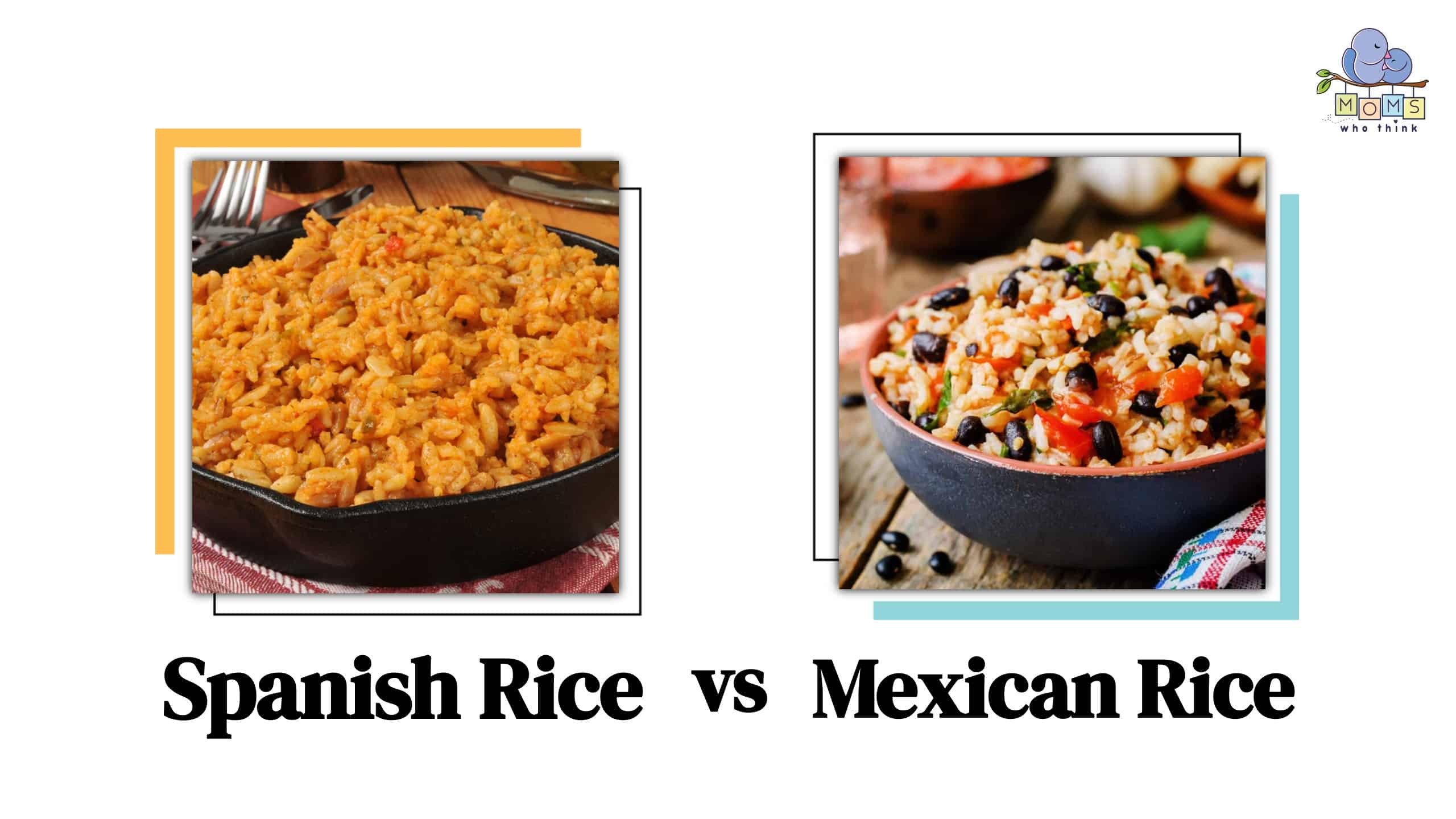Rice complements several dishes and is a rich source of carbohydrates. Some rice kinds may be a whole meal alone, while others are only suitable as a side dish. Spanish and Mexican rice are delightful foods that most people are acquainted with, and many people mistakenly believe they are the same thing when they are not. Spanish rice's flavor is milder than Mexican rice, which is more robust and spicy. Their distinctions, however, do not stop there.
This article will examine the similarities and differences between these two popular rice meals, so keep reading to learn more!
- The must-have convenient reference guide for every home cook!
- Includes more than 8,000 substitutions for ingredients, cookware, and techniques.
- Save time and money on by avoiding trips to grab that "missing" ingredient you don't really need.
Spanish Rice vs. Mexican Rice: What is the Difference?
Spanish rice and Mexican rice are two famous rice dishes with unique flavors, although they are often used interchangeably.
Here are some of their main differences:
Origin
Mexican food has Mayan roots. This may also have originated with the Aztecs and Toltecs, among other indigenous cultures. These indigenous civilizations greatly affect this dish, defining its taste, cooking techniques, and components that constitute this cuisine.
Spanish cuisine evolved through several influences throughout the Middle Ages, including Catholicism, Islamic Moors, and earlier Rome. New products, spices, and cooking techniques paved the way during the Middle Ages, creating the basis for Spanish cuisines such as Paella, which is well-known in today's generation.
Purposes
Mexican rice serves its main purpose as a side dish due to its simplified components. This goes perfectly with viands like steak, seafood, and other flavor-rich dishes. You can also use this for burritos, tacos, and enchiladas.
Contrarily, Spanish rice can be a meal on its own. Its ingredients, such as shrimp, mussels, and calamari, make it its own viand. Given its rich flavor that bursts in your mouth, this has become a staple in Spain and other countries.
Color and Texture
One of the most noticeable distinctions between these two rice meals is that Mexican rice is more fluffy and does not cling together. Spanish rice is firmer, while Mexican rice is softer and practically disintegrates on your tongue. Saffron is used in Spanish rice with a gently sweet flavor and bright yellow appearance. On the other hand, Mexican rice contains cumin, which gives the rice a nice red color.
Flavor
While their similarities make it difficult to tell them apart, their distinct flavors provide two completely distinct sensations. Mexican rice has more heat and nutty flavor than Spanish Rice. Spanish rice has a mild, sweet taste that you can use for sweet and savory meals, while spices such as chili powder, paprika, and cumin give Mexican rice its strong and smokey taste.
Type of Rice
Although both kinds of rice use medium-grain rice, Bomba rice makes Paella or similar classic Spanish dishes better, more authentic, and adds more bite to it.
This rice will make the dish as authentic as possible, and the outcomes are almost always perfect. Although long-grain white rice is the most typical rice for Mexican rice, brown rice is also a fantastic option.
Ingredients
Certain chefs believe Spanish rice must be spiced with saffron, while Mexican rice should be spiced with cumin. These various components give each meal its own unique taste and appearance. Additionally, although both rice recipes use tomato sauce, the “Spanish” version frequently adds chorizo and paprika to the spice mix and does not call for cilantro.
Spanish Rice vs. Mexican Rice: Nutritional Value
Spanish and Mexican rice originate from different culinary traditions but share similar ingredients and flavors. Although they have distinct characteristics, their nutritional values are relatively comparable.
Spanish rice, or “arroz a la española,” typically contains white rice, tomatoes, onions, garlic, and various spices. People often cook it in a tomato-based broth or with chicken stock. The nutritional value of Spanish rice depends on the specific recipe and cooking methods used. Generally, it provides good carbohydrates and essential minerals like iron and potassium. However, it may also have higher sodium due to broth or seasoning ingredients.
Mexican rice, or “arroz mexicano,” is famous for its vibrant color and bold flavors. It usually consists of long-grain rice, tomatoes, onions, garlic, and chili peppers. People often cook rice in chicken broth or vegetable stock to enhance its flavor. Like Spanish rice, Mexican rice offers good carbohydrates and some essential minerals. However, it may have a slightly higher calorie content due to adding oil or other fats during cooking.
To make Spanish and Mexican rice more nutritious, one can add vegetables like bell peppers, peas, or carrots, which provide fiber, vitamins, and antioxidants. Additionally, whole-grain rice, instead of white rice increases fiber content and nutrient density. However, it's important to note that specific nutritional values can vary based on the recipe and cooking methods.
Spanish rice and Mexican rice offer a good source of carbohydrates and some essential minerals. Their overall nutritional profile can be improved by incorporating vegetables and opting for healthier cooking techniques, such as using whole-grain rice.
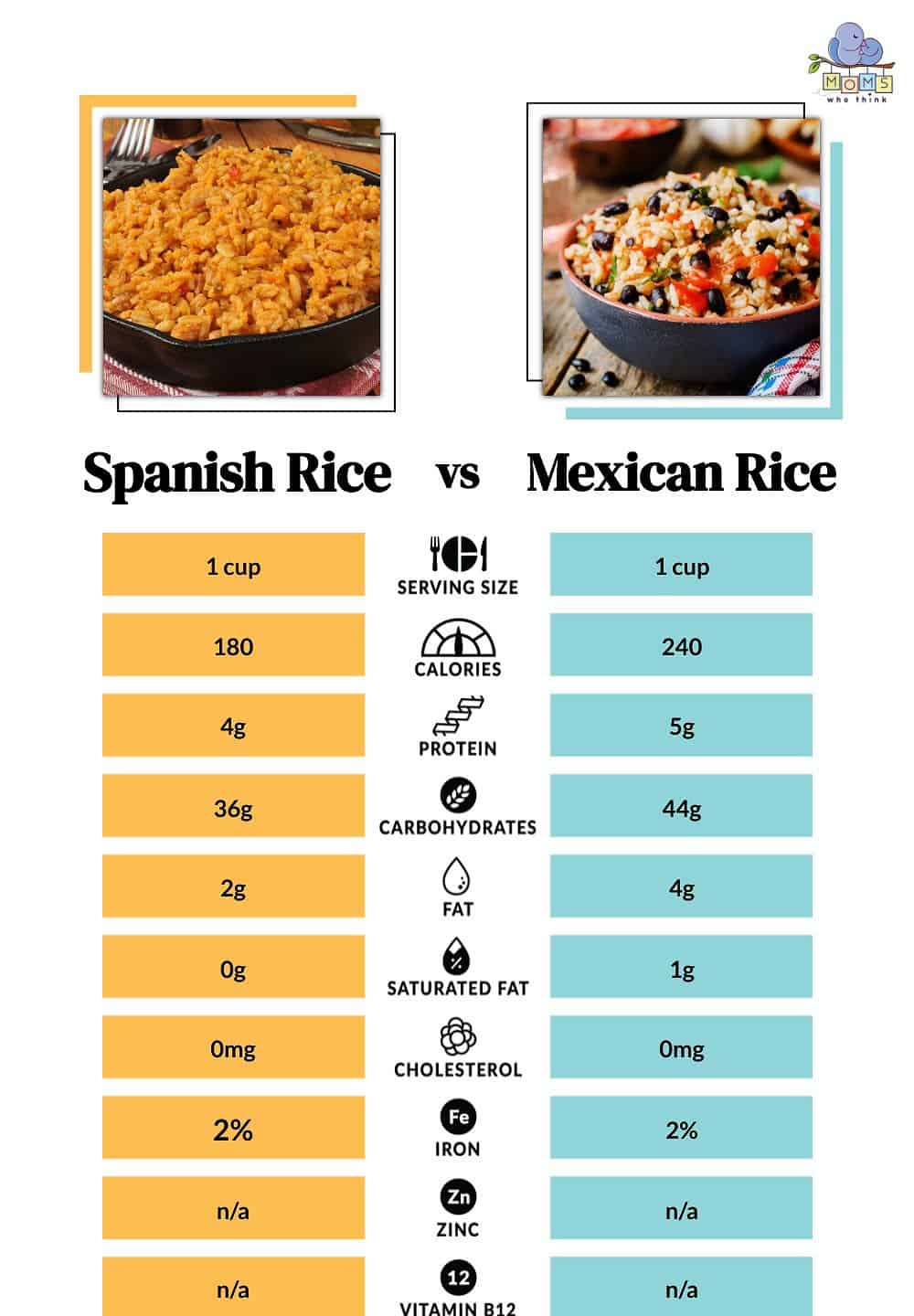
©
What is Spanish Rice?
Paella, another name for Spanish rice, is a unique dish that is very simple to make and goes well with almost anything. The dish is particularly linked to Valencia, located in the rice-growing regions of Spain's Mediterranean coast, where it originated.
This is a short-grain or long-grain white rice cooked in the form of a Spanish pilaf and seasoned with saffron, bell pepper, onion, and garlic, and mixed with vegetables, seafood, and meat. Saffron gives Spanish rice its sweet-savory flavor and golden hue. Saffron has a subdued earthy-sweet taste composition with a hint of bitterness that transitions to subtle floral and honey overtones, all of which are flavors prominent in Spanish rice. This spice also gives the rice an all-natural yellow color.
What is Mexican Rice?
Mexican red rice, also known as arroz rojo, is a mainstay of the cuisine and is presumably the most frequently served side dish in various restaurants. Mexican rice is made of long-grain rice that has been fried before being boiled in a tomato-and-pepper stock. This is made using an easy mix of onion, cilantro, bell peppers, garlic, jalapeño, tomato sauce, parsley, oregano, stock, and spices.
People love to devour this with tortilla chips and enjoy it as a main course. Mexican rice is the ideal side dish for almost any main entrée, including tacos, fajitas, quesadillas, and enchiladas. Mexican rice goes well with any Mexican bean meal, but refried beans are the most common. Its most distinctive feature is the reddish-orange color that Mexican rice acquires from cooking with cumin. Cumin gives this dish an instant flavor boost. It is rich, hearty, spicy, and earthy, with a citrusy touch.
- The must-have convenient reference guide for every home cook!
- Includes more than 8,000 substitutions for ingredients, cookware, and techniques.
- Save time and money on by avoiding trips to grab that "missing" ingredient you don't really need.
Similarities between Spanish Rice and Mexican Rice
Spanish rice is known as Paella, while Mexican rice is known as Arroz Rojo. Spanish rice and Mexican rice have comparable Latin American-inspired aromas with a base of chicken stock or bouillon and frequently incorporate diced tomatoes and other vegetables. They are spicy and pair nicely with classic Latin and Spanish cuisine, owing to their distinctive flavor from stocks.
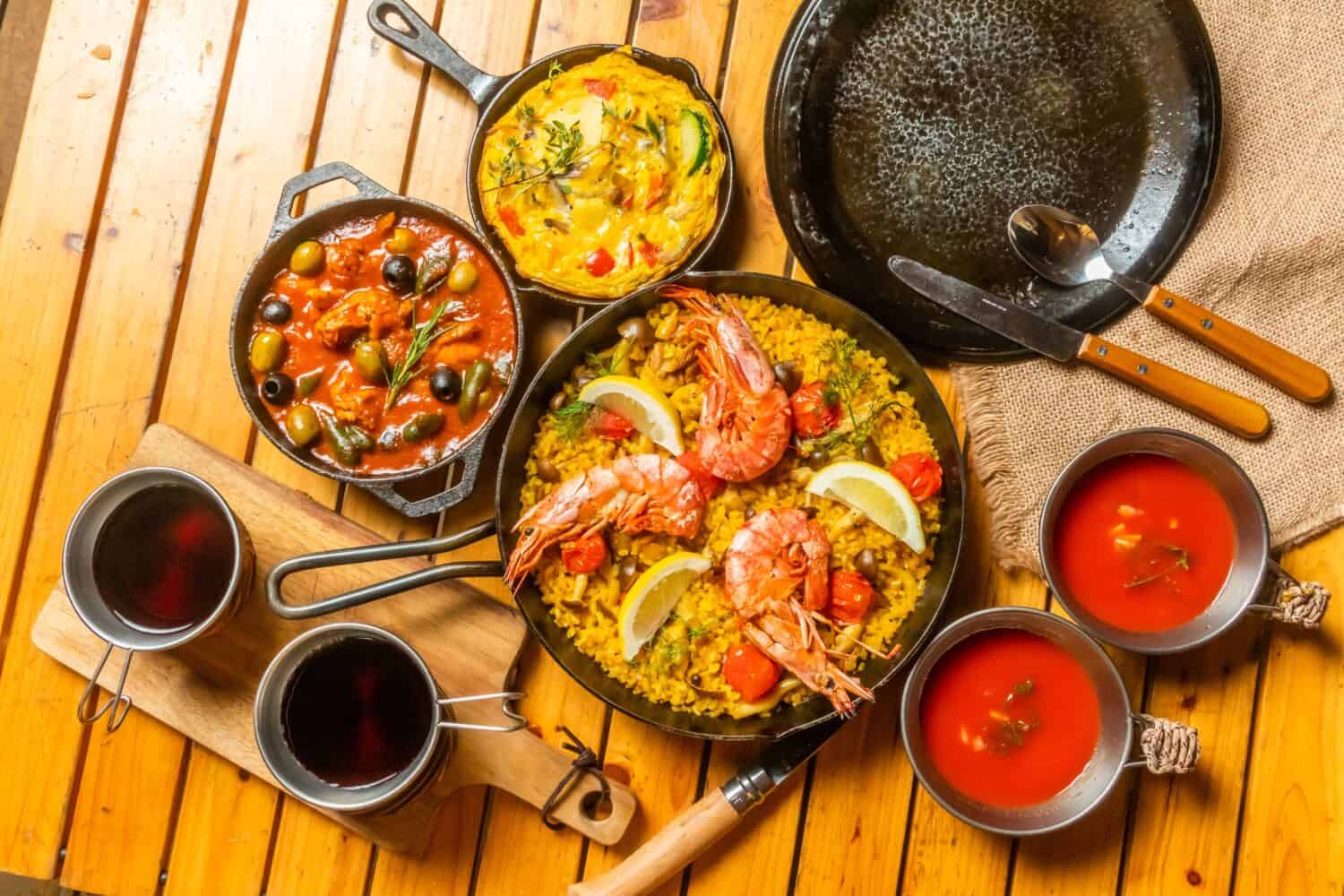
©norikko/Shutterstock.com
Health Benefits of Spanish Rice and Mexican Rice:
They are almost identical in terms of health advantages. It may be tough to believe that both rice recipes provide a steady source of nutrients.
- The first significant health advantage of Spanish and Mexican rice is that it is a good source of vitamin C. This source comes from the mixture of green pepper and tomato sauce. Vitamin C strengthens the immune system, lowers the frequency of allergic responses, and aids in fighting against infections.
- Spanish and Mexican rice are high in iron, vitamins, and minerals, which help generate red blood cells (RBCs) in the body.
- Lactose-free Mexican rice is high in carbohydrates, which provide energy to the body. This is an excellent meal choice for people who want both nutrients and taste and those who are bulking.
- These two additionally help tighten a loose stool by regulating bowel motions, which is an extra health benefit. This is made possible by insoluble fibers contained in rice.
- Spanish and Mexican Rice is also abundant in Vitamin A, which is essential for improving eyesight. It is incredibly good in protecting the retina and keeping the eyes moist.
Which rice is healthier?
There aren't many differences between Mexican and Spanish rice with regard to nutritional value. You can always include both Mexican and Spanish rice in a healthy diet if they are cooked with complete, unprocessed foods, have low salt and added fat content, and are eaten in moderation.
Which is tastier?
Mexican rice has a more intense flavor than Spanish rice. Compared to the strong flavor of Mexican rice, Spanish rice offers a more subtle flavor, making it a better choice for recipes in which you don't want both flavors to compete with one another.
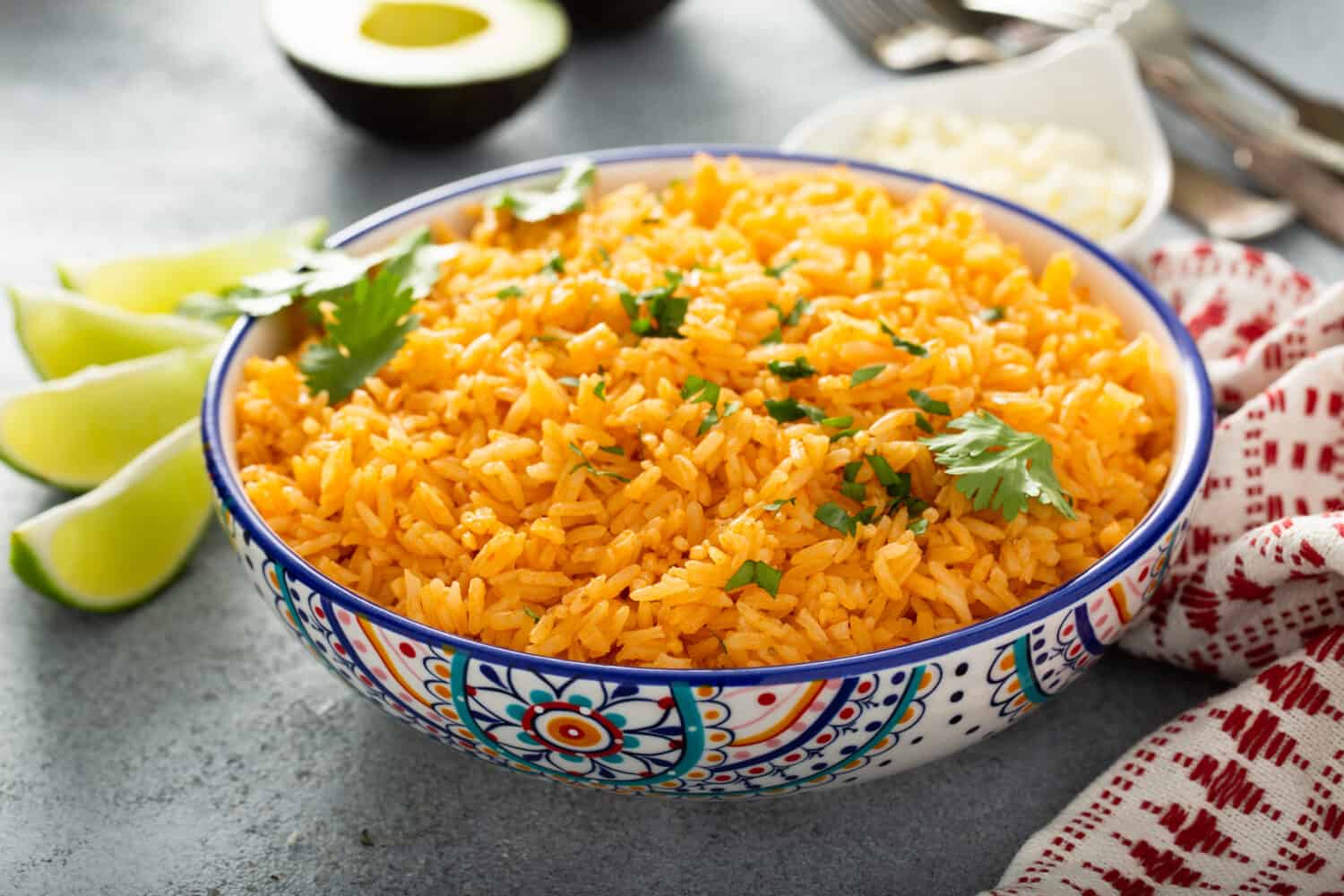
©Elena Veselova/Shutterstock.com
Can I substitute one for the other?
Certainly, however, there will be noticeable differences that may be a little bothersome since Mexican rice has a more intense flavor profile and might affect the dish you are trying to pair it with.
While they are very different, they do share certain similarities, such as having the same base, which is rice, and both containing stock, tomatoes, and onions, which makes them still fit for each other's replacement.
Although substituting one with the other will not offer you the authentic sensation you desire, the choice of replacing one with the other still depends on your preference. Simply be inventive and experiment with the two rice dishes to uncover a unique touch between both of them.
- The must-have convenient reference guide for every home cook!
- Includes more than 8,000 substitutions for ingredients, cookware, and techniques.
- Save time and money on by avoiding trips to grab that "missing" ingredient you don't really need.
Conclusion
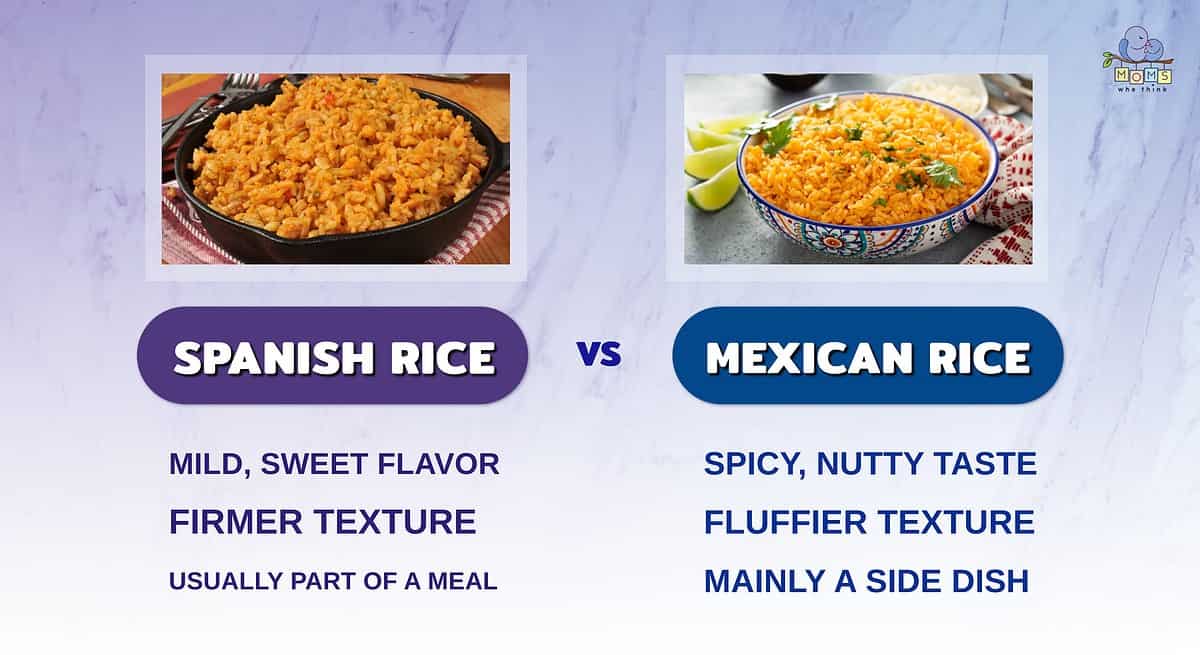
Spanish rice and Mexican rice are both common rice dishes that go well with a range of dishes, but they have various taste profiles that reflect their varying cultural heritages.
While Mexican rice has become renowned for its more intense taste owing to its combination of spices such as cumin and chili powder, Spanish rice is known for its more delicate, somewhat sweeter taste, with saffron and tomatoes serving as its essential ingredients.
The tasty mix of meat or seafood in Spanish rice may appeal to certain individuals, whereas Mexican rice served as a side dish may be more appealing to others due to its strong, savory, and fragrant characteristics. Both alternatives are versatile and delightful in their own right since they provide delectable ways to eat rice and go well with a variety of foods.
Whether you want a dish with more Spanish roots or something with a spicier taste, both Spanish rice and Mexican rice are delicious options. Here are some ways that these two differ:
- While both options have some spice, Mexican rice is typically spicer than Spanish rice.
- One of the main differences is that of taste. Mexican rice has a smokier flavor, while Spanish rice has more of a sweetness to it.
- Both are great as a side dish for the main course; Spanish rice is typically used in main dishes, like the popular paella.
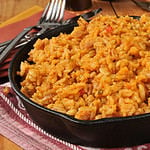
Spanish Rice
Ingredients
- 1 cup long-grain white rice
- 2 tablespoons vegetable oil or olive oil
- 1 small onion, finely chopped
- 1 bell pepper (any color), finely chopped
- 2 cloves garlic, minced
- 1 can (14 ounces) diced tomatoes (or 2 fresh tomatoes, diced)
- 1 3/4 cups chicken or vegetable broth (or water)
- 1 teaspoon chili powder
- 1/2 teaspoon cumin
- Salt and pepper to taste
- Optional garnishes: chopped fresh cilantro, lime wedges
Instructions
- Place the rice in a fine-mesh strainer and rinse it under cold running water until the water runs clear. This helps remove excess starch and prevents the rice from becoming too sticky.
- In a large skillet or frying pan, heat the vegetable oil over medium-high heat. Add the chopped onion and bell pepper. Sauté for about 3-4 minutes until they start to soften.
- Stir in the minced garlic, chili powder, and cumin. Sauté for an additional 30 seconds until fragrant.
- Add the rinsed rice to the skillet and stir to coat it with the oil and spices. Cook for 1-2 minutes, stirring occasionally, until the rice turns slightly translucent.
- Pour in the diced tomatoes and chicken or vegetable broth (or water). Stir to combine everything. Season with salt and pepper to taste.
- Increase the heat to high and bring the mixture to a boil.
- Once it boils, reduce the heat to low and cover the skillet with a tight-fitting lid. Let the rice simmer for about 18-20 minutes, or until the liquid is absorbed, and the rice is tender. Avoid lifting the lid during this time to ensure even cooking.
- Remove the skillet from heat and let it sit, covered, for an additional 5 minutes. This allows the rice to steam and become fluffy.
- Before serving, fluff the rice with a fork to separate the grains. Garnish with chopped fresh cilantro and serve with lime wedges on the side.
